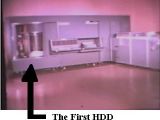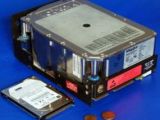The first hard disk saw the light of the labs at Crown Zellerbach in San Francisco, the first company to install a RAMAC (Random Access Method of Accounting and Control) machine, the first IBM computer with a piece of storage technology called a hard drive, according to Jim Porter, president of analysis firm Disk Trend. At the time, many thought of devising a magnetic cylinder. Even the HDD it's possibly influenced by Drum memory devices, which were invented in 1932. "The problem with cylinders, though, is surface area: A cylinder capable of holding 5MB of data with the materials at the time would have been at least 17 feet long. Johnson came up with the idea of stacking magnetic disks", said Al Hoagland, who runs the Magnetic Disk Heritage Center and worked on the RAMAC with Johnson.
The RAMAC was officially announced on September 13, 1956 and weighed 1 ton. It stored 5MB of data on 50 spinning platters with a diameter of 24 inches. Jim Porter worked at Crown in those times, and recalls that "Any time we had a business guest, they wanted to see it, so I'd take them three levels below Market Street to the computer room. You could see the head assembly moving back and forth. It put on a good show. I showed it off dozens of times. It made a fair amount of noise because there was forced air that blew out between the head and the disk to keep the head from rubbing on the disk. It was the air compressor that made the noise".
This was done after IBM opened in 1952 a research lab in San Jose under Rey Johnson, and one of its first assignments was to come up with a magnetic storage system that could hold 5MB of data. Johnson's group used platters coated with magnetic material stacked on top of each other. Data was obtained by a head that traveled up and down the stack of rotating platters. At first, they were arranged horizontally, but later, a vertical shaft was chosen to simplify the addition of other access mechanisms.
In 1957, a prototype was used to demonstrate the new technology using disk drive heads and tracks instead of magnetic tape. The first commercial use of this technology was the IBM 3330, in 1971, when IBM started shipping disks with the Merlin technology that allowed the drive head track the platter better. Until then, IBM came up with a storage system based on packs of six 14 inch disks, with each pack holding 2 MB (1.78 MB per square inch were obtained in 1973). Companies shared this systems, leasing time and space when required, at a price that was 38% higher than the price of oil at that time, 7.81$ / 1 MB.
In 1961, The IBM 1301 Disk Storage Unit Control System Meganical International System was announced, introducing the usage of a separate head for each data surface. That led to the first disk drive to use removable media (the IBM 1311 drive), which used the IBM 1316 disk pack to store two million characters.
In 1979, IBM developed an 8-inch drive, and the Thin Film head, the ancestor of the Giant Magneto Resistive head (developed in 1997), that allowed for greater accuracy in data positioning, directly leading to improvements in areal density. 250.000 of these heads can be stacked up and the height would be less than an inch.
In 1980, the Winchester drive was born; based on a model from 1973. IBM introduced the 3340 "Winchester" disk system, the first to use a sealed head/disk assembly (HDA). Almost all modern disk drives now use this technology, and the term "Winchester" became a common description for all hard disks, though generally falling out of use. Project head designer/ lead designer Kenneth Haughton named it after the Winchester 30-30 rifle (initially called the "30-30" because of its two 30 MB spindles).
In 1982, Hitachi shipped the first drive with more than 1GB of storage. The 1.2 GB H-8598 consisted of ten 14-inch platters and two read-write heads. Six years later, Hitachi shipped a 1.89 GB drive made from eight 9.5-inch disks, which reduced the kilogram-to-gigabyte ratio from 121 kilograms/gigabyte to 42 Kg/GB. Hitachi claimed this latter drive was the first mainframe class drive that a single human could carry. Because of their size and the fact that they broke easily, hard disks were not commonly used with microcomputers until after 1980, when Seagate Technology introduced the Shugart ST-506, the first 5.25-inch hard drive, with a capacity of 5 megabytes. In fact, in its factory configuration, the original IBM PC (IBM 5150) was not equipped with a hard drive. Most microcomputer hard disk drives in the early 1980s were not sold under their manufacturer's names, but by OEMs as part of larger peripherals (such as the Corvus Disk System and the Apple ProFile). The IBM PC/XT had an internal hard disk, however, and this started a trend toward buying "bare" drives and installing them into a system.
In 1983, Rodine issues a 10 MB 3.25 inch drive, and later, in 1988, PrairieTek releases its 2.5 inch 20 MB drive, largely used in notebooks.
In 1986, SCSI (Small Computer System Interface) arrived and was standardized. An early competitor with ESDI, originally named SASI for Shugart Associates, SCSI drives were standard on servers, workstations, and Apple Macintosh computers through the mid-90's, by which time, most models had been transitioned to IDE (and later, SATA) family drives. Only in 2005 did the capacity of SCSI drives fall behind IDE drive technology, though the highest-performance drives are still available in SCSI and Fibre Channel only. The length limitations of the data cable allows for external SCSI devices. Originally, SCSI data cables used single ended data transmission, but server class SCSI could use differential transmission, and then Fibre Channel (FC) interface, and then more specifically the Fibre Channel Arbitrated Loop (FC-AL), connected SCSI hard drives using fiber optics. FC-AL is the cornerstone of storage area networks, although other protocols like iSCSI and ATA over Ethernet have been developed as well. Here are all drive families: MFM (Modified frequency modulation), RLL (Run length limited), ESDI (Enhanced small disk interface), IDE (Integrated Drive Electronics, later renamed to ATA, and then PATA), SATA (Serial ATA), SAS (Serial Attached SCSI), EIDE (an update from Western Digital to IDE).
After 1990, the technologies, HDD technologies jumped. The PRML (Digital Read Channel - Partial Response maximum Likelihood algorithm), LZT (Laser Textured Landing Zones), GMR (Giant MR, see earlier for details), Ultra-DMA and ATAPI were standardized. Integrated Peripherals debuts its 1.8 inch drive. A year later, HP produces a 1.3 inch drive. In 1999, IBM releases a 1 inch micro-drive. In 2004, Toshiba shrinks the drive to 0.85 inches.
All this drive shrinking didn't affect its capacity to store more and more data. In fact, just the opposite occurred. Despite the tough financial circumstances of the drive world, the technology has aged well. Drive makers have generally managed to double the capacity of their products every couple of years for decades. During the '90s, capacity was doubling almost every year. Perpendicular recording, in which bits are stacked on top of each other on a platter, may enable drive makers to once again accelerate the density growth rate over the next few years. In 2010, drives are set to be capable of storing 500 GB to 1 TB per square inch.
"We can see 50 to 100 TB per square inch being possible. Mother Nature has provided us with a technology that is scalable to very, very high densities, so you just keep working at the problem with enough engineers, and you make progress on it steadily. The hard drive has advanced about 65 million times in areal density since the RAMAC, and we're still, in my estimation, three orders of magnitude from any truly fundamental limits", said Mark Kryder, chief technical officer of Seagate Technology. In comparison to the RAMAC, manufacturers now sell drives that hold over 150.000 times more data. However, you should know a couple of things about the capacity of a HDD. Often, hard drive manufacturers typically specify drive capacity using SI prefixes (International System) definition of the prefixes "giga" and "mega." This is largely for historical reasons, since disk drive storage capacities exceeded millions of bytes long before there were standard binary prefixes and even before there were the SI prefixes in 1960. Binary prefixes' were standardized in 1999. As it turned out, many practitioners early on in the computer and semiconductor industries adopted the term kilobyte to describe 210 (1024) bytes because 1024 is "close enough" to the metric prefix kilo, which is defined as 103 or 1000. Sometimes, this non-SI conforming usage includes a qualifier such as 1 kb = 1,024 Bytes, but this qualifier was frequently omitted, particularly in marketing literature. This trend became habit and continued to be applied to the prefixes "mega", "giga", "tera", and even "peta". Operating systems and their utilities frequently report capacity using binary prefixes which results in a discrepancy between the drive manufacturer's stated capacity and the system's reported capacity. Obviously, the difference becomes much more noticeable in reported capacities in the multiple gigabyte range, and users will often notice that the volume capacity reported by their OS is significantly less than that advertised by the hard drive manufacturer. For example, Windows reports drive capacity both in decimal to 12 or more significant digits and with binary prefixes to 3 significant digits. Thus a disk drive specified by a drive manufacturer as a 30 GB drive has its capacity reported by Windows both as '30,065,098,568 bytes' and '28.0 GB'. Since utilities provided by the operating system probably define a gigabyte as 230, or 1073741824, bytes, the reported capacity of the drive will be closer to 28.0 GB, a difference of approximately 7%. For this very reason, many utilities that report capacity have begun to use the aforementioned IEC standard binary prefixes (KiB, MiB, GiB) since their definitions are unambiguous. Many people mistakenly attribute the discrepancy in reported and specified capacities to reserved space used for file system and partition accounting information. However, for large file systems, this data rarely occupies more than a few MB, and therefore, cannot possibly account for the apparent "loss" of tens of GBs.
What about the price? Here is a prediction made in 1981 in Creative Computing Magazine: "The cost for 128 kb of memory will fall below 100$ in the near future". At that rate, the price of a 256 MB module would be 200.000$. If you would want 2 GB, you would have to pay 2.000.000$ for that. I've found some documents that show the rapid fall of prices. Here are the "Costs for MB" from the beginning until now: 1956: 10.000$ / 1MB 1980: 200$ / 1MB 1981: 130$ up to 700$ / 1MB 1982: 260$ / 1MB 1984: 80$ / 1MB 1987: 45$ / 1MB 1988: 15$ / 1MB 1989: 10$ / 1MB 1990: 9$ / 1MB 1991: 7$ / 1MB 1992: 4$ / 1MB 1993: 2$ / 1MB 1995: 0.6$ / 1MB 1996: 0.1$ / 1MB Between 1997 and 1999: 0.02$ / 1MB In 2000: 0.01$ / 1MB was surpassed, as 1 GB was available for 9.5$ at start, then dropped to 6.9$. 2001: 3$ / 1GB 2002: 2.2$ / 1GB 2003: 1.5$ / 1GB 2004: 1.1$ / 1GB 2005: 1$ / 1GB 2006: Not calculated yet, but obviously lower.
All this started with just a hard disk drive (HDD, hard disk, hard drive, fixed disk, fixed drive, fixed disk drive, usage hard file) defined as "a non-volatile, digitally encoded data storage device that stores data on the magnetic surfaces of hard disk platters" (according to Wikipedia). As for the numbers, compared to "the one" product from 1956, this year, 450.000.000 drives will be manufactured, according to Disk Trend. The top three makers, Seagate (which just acquired Maxtor), Western Digital and Hitachi (which owns the former drive manufacturing division of IBM), have 75% of the market. Other noticeable producers are Samsung, Fujitsu and Toshiba.
In the end, it all resumes to money. As Bill Healy from Hitachi puts it better: "As a buyer, someone is going to try to convince you to buy something with 30GB of storage when, for a few dollars more, you can buy something with a 160GB hard drive."
Images: First Hard Disk Smallest Hard Disk, 0.85 Inch Toshiba HDD Evolution Rey Johnson 1 Inch HDD

 14 DAY TRIAL //
14 DAY TRIAL // 




